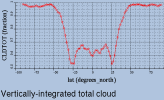Hello,
I'm running slab ocean aquaplanet (QSC6) simulations on CAM6 (from CESM v 2.1.0; no changes), with 1.9° resolution. I made a Q flux profile to match surface fluxes from a QOBS standard fixed SST run. My experiments need the control Q flux profile to be symmetrical, so I averaged the profile between hemispheres and mirrored it about the equator to ensure symmetry. The case is made using:
./create_newcase --case ../cases/aquaasym_CTL_v2 --walltime 24:00:00 --compset QSC6 --res f19_f19_mg17 --machine tetralith --project snic2022-1-1 --output-root /proj/bolinc/users/x_aidjo/cesm2.1.0-out/
I introduced seasonality by including orbital parameters in user_nl_cpl:
orb_eccen = 0.
orb_obliq = 23.5
orb_mvelp = 0.
orb_mode = "fixed_parameters"
And commented these two lines in the following block in seq_infodata_mod.F90 file and put it into SourceMods/src.drv/:
if ( infodata%aqua_planet ) then
infodata%aqua_planet_sst = 1
!infodata%perpetual = .true.
!infodata%perpetual_ymd = aqua_perpetual_ymd
endif
I have included a user_docn.streams.txt.som file with the path to the file, and made these xmlchanges:
$ ./xmlchange DOCN_SOM_FILENAME="aqua_baro_qflux_ctl.nc"
$ ./xmlchange STOP_OPTION=nyears,STOP_N=5,RESUBMIT=2
$ ./case.submit
The compiler is buildenv-intel/2018.u1-bare netCDF-HDF5/4.6.2-nsc1-parallel-private_hdf5-intel20018a-eb. Seasonality is working and after equilibrium is reached and checked against my prescribed Q flux profile, but I am getting a northerly ITCZ position. I have heard from a colleague that there can be multiple stable solutions and hysteresis in the position location's solution, but I also looked at the hemispheric differences in insolation, and there is a greater amount of annual average insolation in the SH than the NH, indicating there are some asymmetries – will need to solve this before proceeding.
Is it possible that the orbital eccentricity = 0 is not being passed to the model, and is there an extra line to comment/change in a source mod?
Thanks,
Aiden
I'm running slab ocean aquaplanet (QSC6) simulations on CAM6 (from CESM v 2.1.0; no changes), with 1.9° resolution. I made a Q flux profile to match surface fluxes from a QOBS standard fixed SST run. My experiments need the control Q flux profile to be symmetrical, so I averaged the profile between hemispheres and mirrored it about the equator to ensure symmetry. The case is made using:
./create_newcase --case ../cases/aquaasym_CTL_v2 --walltime 24:00:00 --compset QSC6 --res f19_f19_mg17 --machine tetralith --project snic2022-1-1 --output-root /proj/bolinc/users/x_aidjo/cesm2.1.0-out/
I introduced seasonality by including orbital parameters in user_nl_cpl:
orb_eccen = 0.
orb_obliq = 23.5
orb_mvelp = 0.
orb_mode = "fixed_parameters"
And commented these two lines in the following block in seq_infodata_mod.F90 file and put it into SourceMods/src.drv/:
if ( infodata%aqua_planet ) then
infodata%aqua_planet_sst = 1
!infodata%perpetual = .true.
!infodata%perpetual_ymd = aqua_perpetual_ymd
endif
I have included a user_docn.streams.txt.som file with the path to the file, and made these xmlchanges:
$ ./xmlchange DOCN_SOM_FILENAME="aqua_baro_qflux_ctl.nc"
$ ./xmlchange STOP_OPTION=nyears,STOP_N=5,RESUBMIT=2
$ ./case.submit
The compiler is buildenv-intel/2018.u1-bare netCDF-HDF5/4.6.2-nsc1-parallel-private_hdf5-intel20018a-eb. Seasonality is working and after equilibrium is reached and checked against my prescribed Q flux profile, but I am getting a northerly ITCZ position. I have heard from a colleague that there can be multiple stable solutions and hysteresis in the position location's solution, but I also looked at the hemispheric differences in insolation, and there is a greater amount of annual average insolation in the SH than the NH, indicating there are some asymmetries – will need to solve this before proceeding.
Is it possible that the orbital eccentricity = 0 is not being passed to the model, and is there an extra line to comment/change in a source mod?
Thanks,
Aiden

